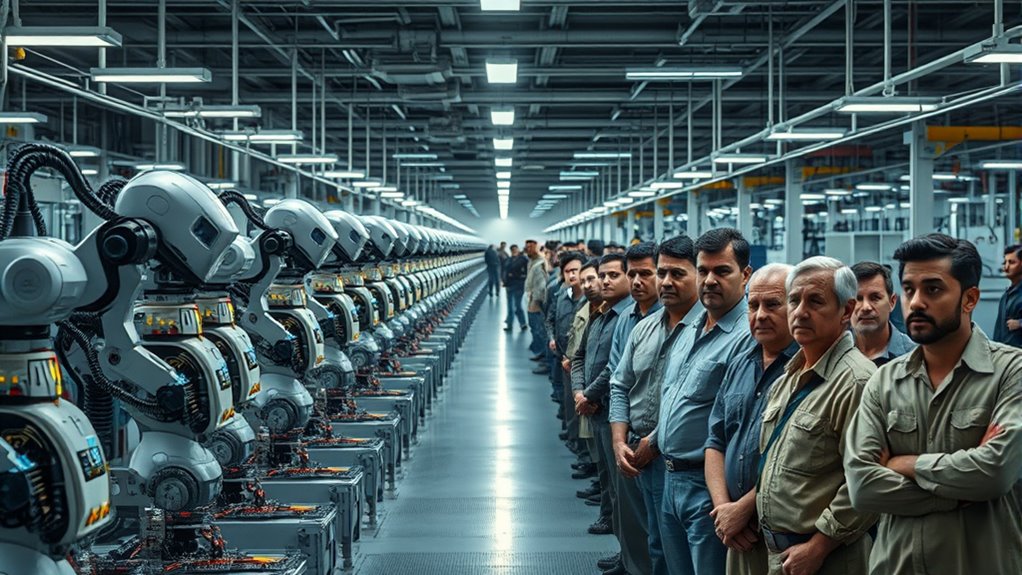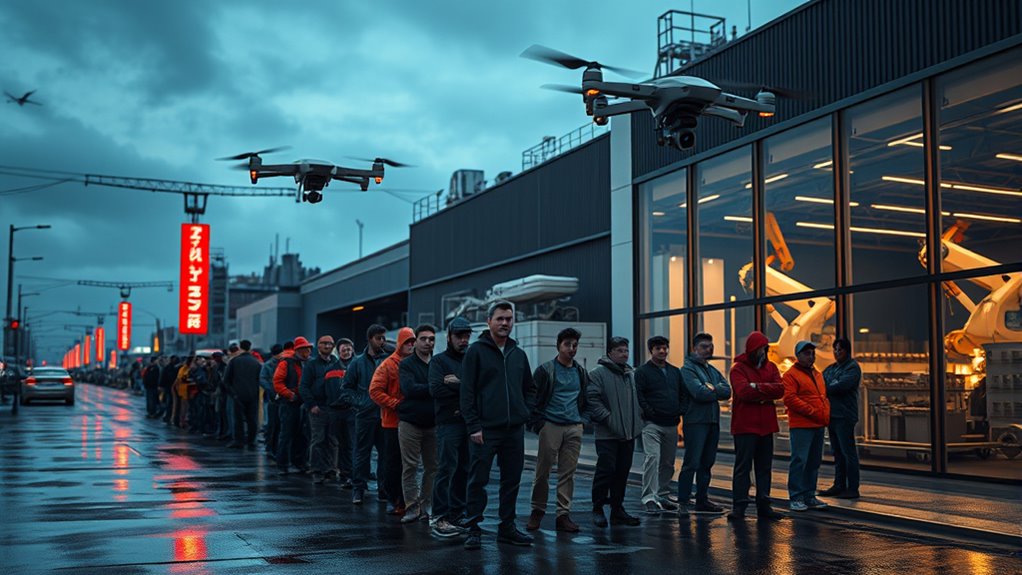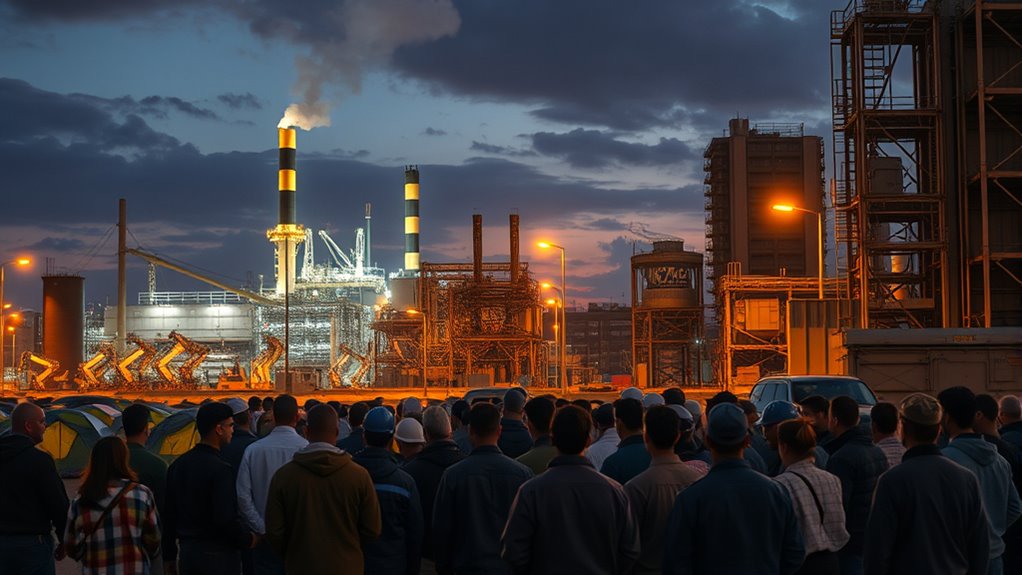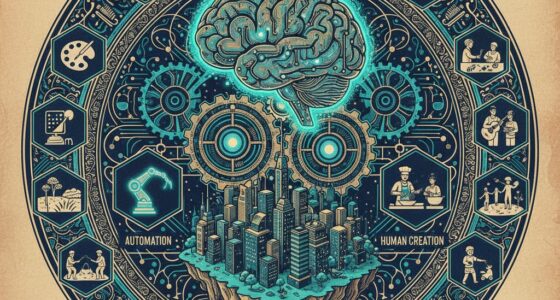Automation is quickly transforming industries and threatens to widen the wealth gap. As machines replace routine jobs, mainly held by less skilled workers, those with advanced skills and capital benefit more, consolidating wealth. Younger and less experienced workers face higher displacement risks, deepening inequality. Without targeted policies, this trend will likely intensify, leaving many behind. To understand how these shifts could impact you and what can be done, explore further insights below.
Key Takeaways
- Automation disproportionately affects low- and middle-skilled jobs, increasing unemployment and economic insecurity for vulnerable workers.
- Wealth and income are concentrated among those with advanced skills or capital, widening the wealth gap.
- Limited access to upskilling and retraining hampers displaced workers’ ability to adapt, deepening inequality.
- Rapid technological change may accelerate wealth accumulation among tech-savvy and capital-owning elites.
- Policy gaps and insufficient social safety nets risk exacerbating socioeconomic divides amid automation-driven job losses.
The Scope of Automation’s Reach in the Workforce

Automation is rapidly expanding its reach across various sectors of the workforce, fundamentally transforming how work is performed. You’ll notice that millions of jobs are at risk, especially those involving routine tasks like data entry, manufacturing, and customer service. By 2025, over 7.5 million data entry jobs could disappear due to automation, while 1.7 million manufacturing roles have already been eliminated since 2000. In tech, nearly 78,000 jobs were lost in early 2025 alone. PwC predicts that up to 30% of jobs worldwide might be automatable by the mid-2030s, affecting a broad spectrum of roles. This widespread automation is reshaping employment opportunities, with low-skilled and repetitive jobs most vulnerable to being replaced by AI and machines. Additionally, Honda Tuning modifications demonstrate how technological advancements are also shaping vehicle performance and customization, reflecting broader trends in automation and innovation.
Sectors and Roles Most Vulnerable to Automation Displacement

Certain sectors and roles face a higher risk of displacement as AI and automation technologies advance rapidly. You’ll find clerical and administrative jobs, like secretaries and data entry clerks, most vulnerable because repetitive tasks are easily automated. Retail roles such as cashiers and bank tellers are declining sharply due to self-service technologies, with teller jobs projected to drop 15% by 2033. Manufacturing and low-skilled service jobs, including assembly line work and basic customer service, are also at significant risk. AI-driven chatbots and virtual assistants increasingly replace customer support roles, leading to employment declines. Even some early-career tech positions, like junior software developers, face automation pressures. If you work in these sectors, automation’s rapid pace could threaten your job stability in the near future.
Disproportionate Impact on Younger and Less Experienced Workers

Have you noticed that younger and less experienced workers are bearing the brunt of recent job disruptions? They face higher unemployment rates and fewer opportunities as automation replaces routine tasks. Data shows early-career workers (ages 22-25) experienced a 13% employment decline from late 2022 to mid-2025, and unemployment among 20-30-year-olds has risen nearly 3 percentage points. These workers often lack the experience or skills to adapt quickly. The table below highlights how different groups are affected:
| Group | Impact |
|---|---|
| Young workers (20-25) | 13% employment decline, rising unemployment |
| Less experienced workers | Higher automation risk, fewer reskilling options |
| Entry-level tech workers | Notable job declines due to AI exposure |
Additionally, the rapid advancement of automation technology further accelerates these trends, making it even more challenging for less experienced workers to stay employed.
Widening Income Inequality and Wealth Concentration Trends

Widening income inequality and the concentration of wealth are accelerating as AI and automation reshape the job landscape. You can picture a growing divide:
- The top 10% of earners control nearly 70% of wealth, while middle and lower-income groups face stagnation.
- Skilled workers in tech and finance see wage gains, widening the earnings gap.
- Routine jobs, often low-wage, decline sharply, pushing many into financial insecurity.
- Wealth accumulates among those with capital and advanced skills, leaving less room for upward mobility.
As automation replaces many lower- and middle-income roles, the rich grow richer, and the gap widens. Without targeted intervention, this trend risks entrenching socioeconomic divisions, making it harder for disadvantaged groups to catch up.
Current Adaptation Strategies and Their Limitations

You may notice that efforts to upskill workers face significant challenges, such as limited access to relevant training and rapid job changes. Policy gaps often leave vulnerable groups without adequate safety nets or support for progression. Meanwhile, the lack of real-time data makes it difficult to measure progress or adjust strategies effectively. Incorporating outdoor‑kitchen essentials into community programs could offer practical skill development opportunities.
Workforce Upskilling Challenges
While upskilling is widely recognized as a key strategy to mitigate job displacement caused by automation, implementing effective training programs faces significant challenges. First, limited access to quality education narrows opportunities for many workers, especially in underserved communities. Second, the rapid pace of technological change makes it hard to design curricula that stay relevant. Third, workers often lack time or resources to pursue additional training while managing existing jobs. Fourth, employers may hesitate to invest in upskilling without clear, immediate benefits. Additionally, Grocery Savings Strategies can help workers allocate resources toward education and training, but many still face barriers to consistent access. Visualize this:
- Workers juggling full-time jobs and evening classes.
- Training platforms struggling to keep up with new AI tools.
- Communities with scarce educational resources.
- Employers unsure if investing in employee skills will pay off. These hurdles hinder efforts to prepare workers for the evolving job landscape.
Policy Gaps and Risks
Current policies aimed at addressing automation’s impact often fall short of closing the gaps created by rapid technological change. Many existing strategies focus on short-term retraining programs or offering unemployment benefits, but these measures are insufficient for long-term resilience. They often lack targeted support for vulnerable groups, especially younger workers and those in routine jobs most at risk. Additionally, policies tend to underestimate the pace and scale of job displacement, delaying necessary reforms. Without proactive measures like all-encompassing upskilling, social safety nets, and inclusive economic policies, inequality will continue to widen. The risks of policy gaps include increased social unrest, persistent unemployment, and a growing divide between high- and low-income workers. Effective adaptation requires a coordinated, forward-looking approach that anticipates future shifts and addresses structural inequalities head-on. Recognizing the importance of skills development and ongoing education is essential to bridge the emerging gaps created by automation and technological progress.
Limited Real-Time Data
How well do we really understand the ongoing impact of AI-driven automation on the labor market? The truth is, limited real-time data hampers our ability to fully grasp shifts and emerging risks. Imagine:
- Tracking millions of job changes across industries with outdated metrics.
- Identifying which roles are truly at risk versus those temporarily affected.
- Measuring the speed and scale of workforce displacement accurately.
- Forecasting long-term economic and inequality consequences with incomplete information.
- Recognizing how creating the perfect farmhouse bedroom ambience can influence worker well-being and productivity in remote or hybrid settings.
Without precise, timely data, policymakers and workers face challenges in adapting effectively. Current systems often rely on lagging indicators, making it hard to respond quickly or develop targeted solutions. Better real-time data is indispensable to understanding AI’s true impact and designing effective adaptation strategies.
Future Risks and Potential Escalation of Job Losses

You should consider how expanding automation could lead to widespread economic disruption if more jobs become vulnerable. As AI technology advances, the risk of larger-scale job losses will likely increase, affecting both low- and high-skilled sectors. Without proactive policies and preparation, these shifts could deepen existing inequalities and challenge social stability.
Expanded Automation Potential
As AI technology continues to evolve rapidly, the potential for expanded automation poses significant future risks to the labor market. You might imagine a future where more sectors face widespread job displacement, from routine clerical tasks to complex customer service roles. Consider these scenarios:
- Entire administrative teams replaced by AI systems handling scheduling, emails, and data entry.
- Retail counters and call centers fully automated, with robots and chatbots serving customers.
- Manufacturing plants operated by fleets of autonomous robots, minimizing human oversight.
- Creative and analytical jobs, such as basic data analysis or content generation, increasingly performed by AI algorithms.
These developments could accelerate job losses in vulnerable sectors, widening economic divides and challenging social safety nets. The scope of automation’s expansion might reshape employment landscapes more rapidly than expected. Content relevance and authority are crucial factors that influence how quickly these changes impact the job market.
Broader Economic Disruption
The rapid expansion of AI-driven automation raises serious concerns about broader economic disruption that could surpass current impacts. As more industries adopt advanced technologies, job losses may accelerate beyond projections, leading to significant shifts in employment stability. Small and medium-sized businesses might struggle to adapt, risking closures or reduced hiring. Supply chains could face interruptions if automation causes widespread sector contractions. Consumer spending may decline if unemployment rises, dampening economic growth. Financial markets could experience volatility driven by uncertainty about job prospects. This escalation may deepen existing inequalities, disproportionately affecting vulnerable workers. Without careful management, automation’s growth could trigger a cycle of economic instability, highlighting the urgent need to anticipate and mitigate potential disruptions before they become uncontrollable.
Policy and Preparedness
Policy and readiness are crucial as AI-driven job losses could escalate beyond current estimates, posing significant risks to economic stability. Without proactive measures, millions could face unemployment and widening inequality. To prepare, you should consider these actions:
- Implement targeted retraining programs to help displaced workers transition into new roles.
- Establish social safety nets, like enhanced unemployment benefits and universal basic income.
- Develop regulations that ensure responsible AI deployment and protect vulnerable workers.
- Promote public-private partnerships to fund education and workforce development initiatives.
- Recognize that cultivating creativity can aid in developing innovative policies and solutions to navigate technological disruptions.
Imagine a future where automated systems replace entire sectors overnight, leaving communities stranded without support. Your role in shaping policies now will determine whether society adapts or suffers from unchecked automation’s fallout. Preparedness is essential to mitigate risks and foster inclusive growth.
Policy Pathways to Mitigate Inequality and Support Transition

Mitigating inequality and supporting workers through technological shifts require proactive and targeted policy measures. You should focus on investing in robust retraining programs that help displaced workers gain new skills relevant to emerging job markets. Strengthening social safety nets, like expanding unemployment benefits and creating wage subsidies, can cushion economic shocks. Policies encouraging lifelong learning ensure workers adapt as automation evolves. Additionally, implementing progressive taxation and closing wealth gaps can prevent wealth concentration in a few segments. You must also promote inclusive access to education and digital infrastructure so underserved communities aren’t left behind. Finally, fostering public-private partnerships can accelerate innovation while safeguarding workers’ interests. These strategies collectively help transition economies more equitably, ensuring technology benefits everyone, not just a select few. Incorporating privacy policies and transparency about data use can build trust as digital adoption increases.
Frequently Asked Questions
How Accurate Are Current Job Loss Projections Due to AI Automation?
Current job loss projections due to AI automation are reasonably accurate but should be viewed as estimates rather than precise figures. Experts base these projections on current trends, technological capabilities, and historical data. However, rapid advancements and unpredictable shifts in AI adoption may cause actual impacts to differ. You should stay informed and adaptable, as the real effect depends on how businesses, governments, and workers respond to ongoing technological changes.
What Industries Are Likely to See the Fastest Ai-Driven Job Growth?
Industries like healthcare, AI development, and renewable energy are poised for rapid job growth, contrasting sharply with automation’s impact on routine roles. You’ll find new opportunities in tech, data analysis, and green energy sectors as they expand. While some jobs vanish, these fields demand skilled workers, offering a chance for you to upskill. Embrace the shift, because these industries are shaping the future of employment and economic growth.
Can AI Create New Job Opportunities as It Displaces Others?
Yes, AI can create new job opportunities if you adapt and develop new skills. As automation displaces routine roles, new roles emerge in AI development, maintenance, and oversight. You might find opportunities in data analysis, cybersecurity, or AI ethics. Embracing continuous learning and staying flexible will help you tap into these emerging fields, ensuring you stay relevant and benefit from AI-driven growth rather than being left behind.
How Effective Are Current Retraining Programs for Displaced Workers?
Current retraining programs can be helpful but often fall short for displaced workers. You might find some success with upskilling initiatives, especially if they focus on high-demand tech skills or new industries. However, many programs lack sufficient funding, accessibility, or tailored support, making it hard for you to shift smoothly. To truly benefit, these programs need ongoing improvements, better outreach, and stronger partnerships between industry and education sectors.
What Long-Term Socioeconomic Effects Could Widespread Automation Cause?
Imagine a future where automation’s tide pulls some careers under, widening the socioeconomic chasm. You could see increased income inequality as routine jobs vanish and wealth concentrates among high-skilled workers. Lower-income groups may struggle more, facing job scarcity and wage stagnation, while the rich benefit from AI enhancements. Without targeted policies, this imbalance risks deepening societal divides, turning technological progress into a ladder for some and a barrier for others.
Conclusion
If we don’t act now, automation could turn the world upside down, creating a chasm so wide that the wealthy will soar while everyone else sinks into obscurity. Jobs will vanish faster than you can blink, and inequality will explode like a supernova, consuming the middle class in its fiery wake. It’s a race against time—without bold policies and proactive change, we risk losing the very fabric of a fair, balanced society.









